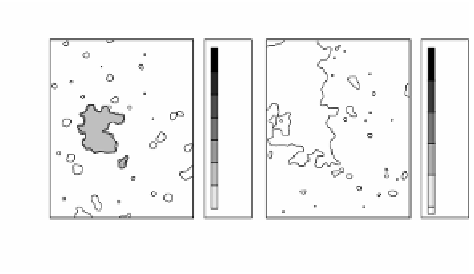Environmental Engineering Reference
In-Depth Information
20cm
(
°
C)
(
°
C)
2500
1900
2200
1600
1900
1300
1600
25cm
1300
1000
1000
700
700
400
400
T
air
=20
°
C
O
2
=20.5%
T
air
=1000
°
C
O
2
=4.0%
(1)
(2)
Figure 2.60
shows 2D distributions of the flame fluctuation for the three conditions.
Note that high temperature air has a significant effect on decreasing the flame fluctu-
ations in the main (middle) combustion region. The flame thermal uniformity is
significantly improved with the use of low oxygen concentration and high temperature
air. The use of high temperature and low oxygen concentration air results in broader
spatial distributions of C
2
molecules and low peak temperatures and larger combustion
volume. The lower flame temperatures are effective to decrease NO
x
emission. The
practical importance of the high temperature air combustion is, therefore, significant
from the point of view of both thermal field uniformity and flame stability.
2.3.3.3 Well-Stirred Reactor
During the development of the advanced furnace utilizing high temperature air by
regeneration, we concluded the nature of the combustion regime for high temperature
air combustion. One opinion was that the regime resembles that of a well-stirred
reactor (WSR), because large volumetric reactions, unlike a jet flame formed with
a typical burner, dominated the furnace. In addition, the temperature distribution in
the furnace became flatter and more uniform with the momentum increase of the
20cm
(a.u.)
100
80
60
25cm
40
20
0
T
air
= 20
O
2
=20.5%
1000
20.5%
1000
7.0%
(1)
(2)
(3)
FIGURE 2.60
Profiles of flame fluctuation (4 Hz).



















































Search WWH ::

Custom Search